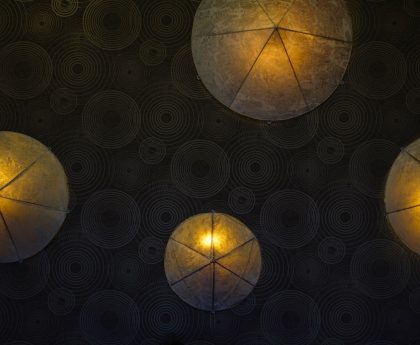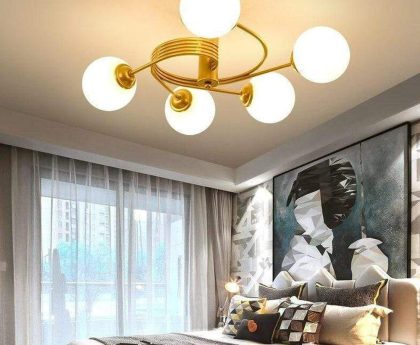When selecting a lamp style for a room, it’s essential to consider the overall design aesthetic. Modern and minimalist spaces often benefit from sleek, simple lamp designs that complement clean lines and neutral color schemes. Traditional or eclectic interiors may be better suited to lamps with ornate details and decorative elements, which can add visual interest and personality to the room.
The lamp’s function is another crucial factor in choosing the right style. For ambient lighting, floor lamps with soft, diffused light are often suitable. Task lighting, such as for reading or desk work, may require table lamps with focused and adjustable light sources.
By considering both the design aesthetic and the lamp’s intended function, one can select a style that is both visually appealing and practical for the space.
Finding the Perfect Size and Scale
Floor Lamps: Considering Height and Proportion
When it comes to floor lamps, you’ll want to consider the height of the lamp in relation to the surrounding furniture and the overall height of the room. A tall floor lamp can help draw the eye upward and create a sense of verticality in a space, while a shorter floor lamp can help create a more intimate and cozy atmosphere.
Table Lamps: Balancing Scale and Size
For table lamps, it’s important to consider the scale of the lamp in relation to the size of the table or surface it will be placed on. A large, oversized table lamp may overwhelm a small side table, while a small, delicate table lamp may get lost on a large console table.
Creating Harmony through Proportion
By finding the perfect size and scale of lamp for your space, you can ensure that it not only looks great but also fits seamlessly into the overall design of the room.
Selecting the Right Type of Lighting
When selecting the right type of lighting for your space, it’s important to consider both the function and mood you want to create. Ambient lighting provides overall illumination and sets the tone for the room, while task lighting is focused and provides light for specific activities such as reading or working. Accent lighting highlights specific features or objects in the room, adding visual interest and depth.
For spaces where you want to create a warm and inviting atmosphere, such as living rooms or bedrooms, you may want to consider soft and diffused lighting options such as floor lamps with fabric shades or table lamps with warm-toned bulbs. In spaces where you need focused lighting for tasks such as reading or working, adjustable desk lamps or swing-arm floor lamps can provide the right amount of light exactly where you need it. By selecting the right type of lighting for each area of your space, you can create a well-lit and functional environment that also enhances the overall design aesthetic.
Incorporating Functional and Decorative Lamps
When incorporating lamps into your space, it’s important to consider both their functional and decorative aspects. Functional lamps provide necessary lighting for tasks and activities, while decorative lamps add visual interest and style to the room. By finding a balance between these two aspects, you can choose lamps that not only look great but also serve a practical purpose in your space.
Functional lamps such as task lighting for desks or reading nooks should prioritize functionality and adjustability to provide the right amount of light exactly where it’s needed. Decorative lamps, on the other hand, can be used to add personality and style to a room through their design, materials, and colors. By incorporating both functional and decorative lamps into your space, you can create a well-lit and visually appealing environment that meets both your practical and aesthetic needs.
Mixing and Matching Different Lamp Styles
Mixing and matching different lamp styles can add depth and visual interest to your space. By combining different types of lamps such as floor lamps, table lamps, and pendant lights, you can create layers of light that enhance the overall ambiance of the room. Mixing different styles of lamps also allows you to play with contrasts and create a dynamic and eclectic look that reflects your personal style.
When mixing and matching different lamp styles, it’s important to consider how they work together in terms of scale, proportion, and design aesthetic. You may want to mix different styles of lamps within the same color palette or material to create a cohesive look, or you may want to intentionally contrast different styles for a more eclectic and curated feel. By experimenting with different combinations of lamp styles, you can create a unique and personalized lighting scheme that adds character and charm to your space.
Utilizing Lamps for Task Lighting
Factors to Consider
When choosing lamps for task lighting, it’s important to consider several key factors. These include adjustability, brightness, and placement. By taking these factors into account, you can ensure that your lamps provide the right amount of light exactly where you need it.
Benefits of Adjustable and Dimmable Lamps
Adjustable desk lamps allow you to direct light precisely where you need it, while dimmable table lamps provide flexibility in creating different levels of brightness for various activities. This flexibility is essential for creating a well-lit space that accommodates different tasks and activities.
Strategic Placement for Optimal Lighting
By strategically placing task lamps in areas where focused lighting is needed, you can ensure that every corner of your home is well-lit and conducive to different tasks and activities. This thoughtful approach to task lighting can greatly enhance the functionality and ambiance of your living spaces.
Incorporating Lamps into Your Overall Design Aesthetic
Incorporating lamps into your overall design aesthetic is an important aspect of creating a cohesive and well-designed space. Lamps not only provide necessary lighting but also contribute to the visual appeal and atmosphere of a room. By considering factors such as style, scale, type of lighting, and functionality, you can choose lamps that seamlessly integrate into your overall design aesthetic.
When incorporating lamps into your design aesthetic, consider how they complement other elements in the room such as furniture, decor, and architectural features. Choose lamps that reflect the same design language as other pieces in the room to create a harmonious look. Additionally, consider how different types of lighting contribute to the mood and ambiance you want to create in each area of your home.
By carefully selecting and placing lamps that align with your design aesthetic, you can elevate the overall look and feel of your space while ensuring that it is well-lit and functional.


